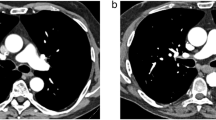Abstract
Purpose
The aim of this study was to describe the prevalence of atherosclerotic plaques based on [18F]-fluorodeoxyglucose (FDG)-positron emission tomography (PET)/computed tomography (CT) in a large population characterized by high risk of cardiovascular disease.
Procedures
One hundred forty-one patients referred to our department for FDG-PET/CT for suspected lung cancer were re-evaluated for atherosclerotic lesions. Cardiovascular risk factors were analyzed based on patient records.
Results
Forty-two percent of the patients had three cardiovascular risk factors or more. Nine percent of all plaques were assessed as active FDG-accumulating plaques, 88% were inactive calcified plaques, and 2% were mixed. The abdominal aorta was the vessel with the highest plaque count. Patients with one risk factor had significantly less active and inactive plaques.
Conclusions
The observed association between the numbers of cardiovascular risk factors and the numbers of FDG-accumulating plaques as well as calcified plaques further supports the validity and value of FDG-PET/CT in the non-invasive identification and characterization of atherosclerotic disease.


Similar content being viewed by others
References
Libby P (2002) Inflammation in atherosclerosis. Nature 420(6917):868–874
Davies MJ (1996) Stability and instability: two faces of coronary atherosclerosis. The Paul Dudley White Lecture 1995. Circulation 94:2013–2020
Fishbein MC, Siegel RJ (1996) How big are coronary atherosclerotic plaques that rupture? Circulation 94(10):2662–2666
Libby P (2006) Atherosclerosis: disease biology affecting the coronary vasculature. Am J Cardiol 98(12A):3Q–9Q
Bleeker-Rovers CP, Bredie SJ, van der Meer JW et al (2003) F-18-fluorodeoxyglucose positron emission tomography in diagnosis and follow-up of patients with different types of vasculitis. Neth J Med 61(10):323–329
Blockmans D, De Ceuninck L, Vanderschueren S et al (2007) Repetitive 18-fluorodeoxyglucose positron emission tomography in isolated polymyalgia rheumatica: a prospective study in 35 patients. Rheumatology (Oxford) 46(4):672–677
Lederman RJ, Raylman RR, Fisher SJ et al (2001) Detection of atherosclerosis using a novel positron-sensitive probe and 18-fluorodeoxyglucose (FDG). Nucl Med Commun 22(7):747–753
Ogawa M, Ishino S, Mukai T et al (2004) (18)F-FDG accumulation in atherosclerotic plaques: immunohistochemical and PET imaging study. J Nucl Med 45(7):1245–1250
Rudd JH, Warburton EA, Fryer TD et al (2002) Imaging atherosclerotic plaque inflammation with [18F]-fluorodeoxyglucose positron emission tomography. Circulation 105(23):2708–2711
Davies JR, Rudd JH, Fryer TD et al (2005) Identification of culprit lesions after transient ischemic attack by combined 18F fluorodeoxy-glucose positron-emission tomography and high-resolution magnetic resonance imaging. Stroke 36(12):2642–2647
Tawakol A, Migrino RQ, Bashian GG et al (2006) In vivo 18F-fluorodeoxyglucose positron emission tomography imaging provides a noninvasive measure of carotid plaque inflammation in patients. J Am Coll Cardiol 48(9):1818–1824
Tahara N, Kai H, Ishibashi M et al (2006) Simvastatin attenuates plaque inflammation: evaluation by fluorodeoxyglucose positron emission tomography. J Am Coll Cardiol 48(9):1825–1831
Ben-Haim S, Kupzov E, Tamir A et al (2004) Evaluation of 18F-FDG uptake and arterial wall calcifications using 18F-FDG PET/CT. J Nucl Med 45(11):1816–1821
Dunphy MP, Freiman A, Larson SM et al (2005) Association of vascular 18F-FDG uptake with vascular calcification. J Nucl Med 46(8):1278–1284
Tahara N, Kai H, Yamagishi S et al (2007) Vascular inflammation evaluated by [18F]-fluorodeoxyglucose positron emission tomography is associated with the metabolic syndrome. J Am Coll Cardiol 49(14):1533–1539
Acknowledgments
This study was supported by the Karolinska University Hospital and the Karolinska Institute.
Author information
Authors and Affiliations
Corresponding author
Rights and permissions
About this article
Cite this article
Wassélius, J.A., Larsson, S.A. & Jacobsson, H. FDG-Accumulating Atherosclerotic Plaques Identified with 18F-FDG-PET/CT in 141 Patients. Mol Imaging Biol 11, 455–459 (2009). https://doi.org/10.1007/s11307-009-0223-2
Received:
Revised:
Accepted:
Published:
Issue Date:
DOI: https://doi.org/10.1007/s11307-009-0223-2




